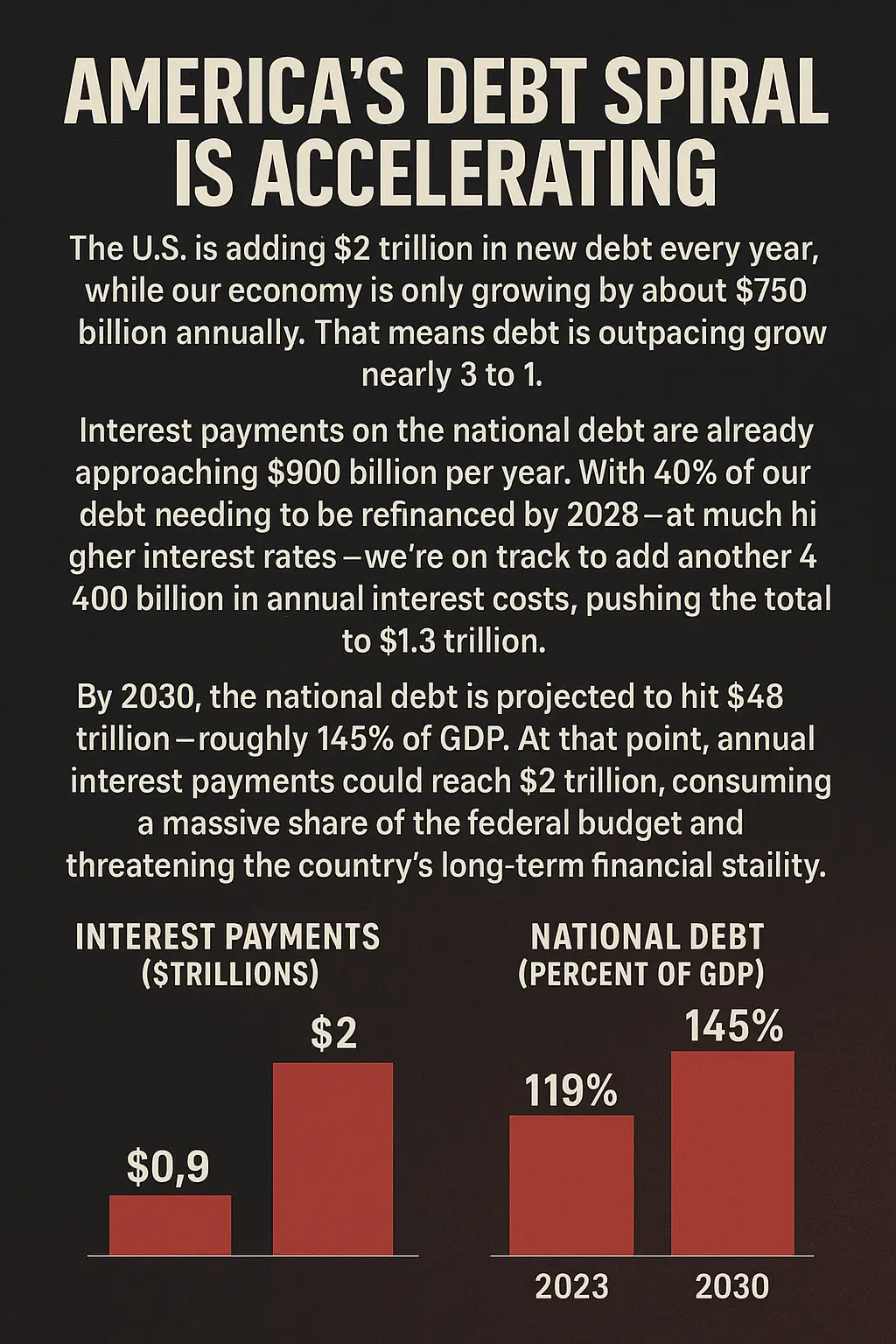The U.S. is adding $2 trillion in new debt every year, while our economy is only growing by about $750 billion annually.
That means debt is outpacing growth nearly 3 to 1.
Interest payments on the national debt are already approaching $900 billion per year.
With 40% of our debt needing to be refinanced by 2028, at much higher interest rates,
we're on track to add another $400 billion in annual interest costs, pushing the total interest payments to $1.3 trillion!
By 2030, the national debt is projected to hit $48 trillion, roughly 145% of GDP.
At that point, annual interest payments could reach $2 trillion per year,
consuming a massive share of the federal budget and threatening the country’s long-term financial stability.

Just the facts!
Key Assumptions:
-
Current national debt: $36 trillion
-
40% refinanced at 4% = +$300–$432 billion in new annual interest
-
Deficits: $2 trillion/year × 3 years = $6 trillion in new borrowing
-
New debt at 4% interest =
6T×0.04=240 billion/year
Cumulative New Interest Burden (Next 3 Years):
| Source | Annual Interest Cost |
|---|---|
| Refinancing $14.4T at 4% | $576B |
| Minus prior cost (assume avg 2%) | −$288B |
| Increase from refinancing | +$288B |
| Interest on $6T new borrowing | +$240B |
| Total Increase | ~$528B |
New Annual Interest Payment Estimate:
-
Current interest: ~$952B
-
+ New cost: ~$528B
-
= Total projected interest by ~2027:
$1.48 trillion per year
Bottom Line:
Yes — unless the U.S. sharply reduces deficits or interest rates fall, you're looking at $1.5 trillion/year in interest costs within 3 years — nearly double today’s levels. That’s more than the U.S. spends on defense or Medicare.
THE SCENARIO YOU DESCRIBE:
Debt: $48 trillion
GDP: $33 trillion
Debt-to-GDP ratio:
4833≈145%
That’s worse than Greece at the height of its debt crisis in 2011. The U.S. would be in uncharted territory for a reserve currency nation.
WHAT HAPPENS NEXT?
1. Interest Becomes the Largest Line Item
If rates hover around 4%, interest on $48T = $1.92 trillion/year — more than defense, Medicare, or Social Security.
That leads to:
Trillion-dollar interest crowding out services
Debt spiral: borrowing to pay interest
Loss of fiscal control
2. Market Revolt
At some point, bond markets will demand higher yields to compensate for:
Risk of inflation
Risk of dollar devaluation
Risk of default (soft or real)
If confidence breaks, yields jump suddenly (as they did in the UK in 2022), forcing the Fed to either:
Let yields rise → Recession, credit freeze
Buy the debt → Money printing → inflation
3. Dollar Devaluation
Foreign holders of U.S. debt start selling Treasuries and diversifying reserves. This could lead to:
A weaker dollar
Imported inflation
Loss of global trust in U.S. fiscal leadership
4. Inflation or Austerity
Policymakers will face a brutal fork:
Let inflation run to erode real debt
Or slash spending & raise taxes during economic stagnation
Neither is politically attractive. Historically, governments inflate their way out — which hurts the poor and middle class most.
HISTORICAL PARALLELS?
Weimar Germany, Argentina, 1970s U.S.
Rome, when its empire relied on debasement
None ended well without a reset.
WHAT’S THE ENDGAME?
Three plausible outcomes:
Soft default: Inflate debt away via high sustained inflation
Hard default: Miss payments, restructure, global shock
Monetary reset: New currency standard, possibly digital or gold-backed, to restore credibility

